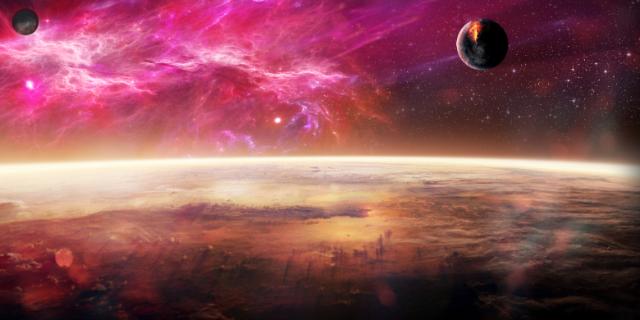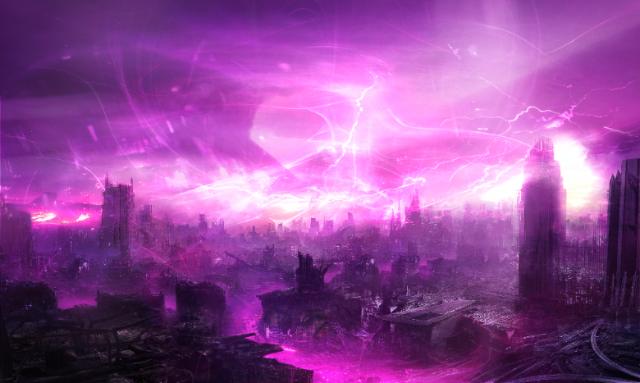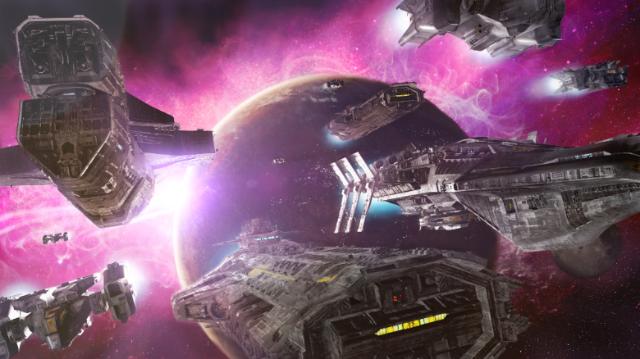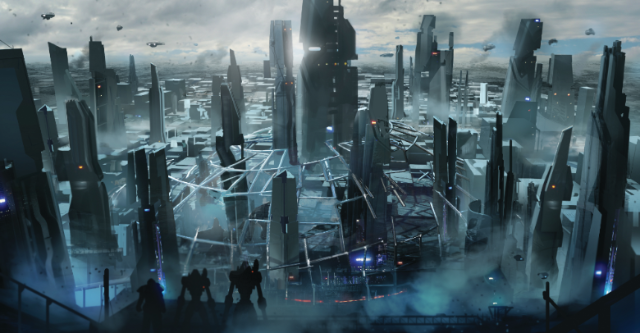Designer's Notes - The Maelstrom
The Maelstrom is the core, central idea to our entire setting. That's ultimately what Maelstrom's Edge is all about, that monumental catastrophe causing previously stable galactic civilisations to tear each other, and themselves, apart. The Maelstrom's implacable advance on the worlds of the Spiral Arm is what feeds the conflict of our universe, sets friend and foe against each other and forces everyone in its path to fight for resources and survival.

When the Maelstrom erupted from humanity's Capital Worlds a millennium ago, it destroyed hundreds of parsecs in the blink of an eye. A colossal energy storm spanning light years, the Maelstrom expanded ever onward, traversing dozens of light years in mere hours. It ripped apart the centre of humanity, destroying worlds in instants and leaving no time for escape. After this initial frenzy, the expansion of the Maelstrom slowed to a fraction of its initial speed as it left the matter dense Capital World systems, its coruscating red and purple blight on the sky becoming a harbinger of utter destruction to nearby worlds.
The Maelstrom travels slowly as it expands through empty space without anything to react with, but moves increasingly more rapidly as it reaches the star system and begins to react with the mass contained within. As the Maelstrom expands, it disrupts the flow of the cybel tunnels nearby, making them impassable to ships - cutting down the routes that people can escape from a system threatened by the Maelstrom and increasing the chances of armed conflict as factions fight for access to the choke point.
Maelstrom's Edge is ultimately a wargame, and conflict between the factions is important to explain why the factions and armies are fighting each other in the battles we play on the tabletop. One of our driving motivations for creating a universe with a central narrative like the Maelstrom is that the factions are forced into difficult decisions to survive. Without such a threat, rebels that invade a spaceport and steal its ships might be considered callous and evil. But if the ships are being hoarded by their corporate owners and taking them by force is the only way that the revolutionaries might survive, suddenly the morals of the situation become a lot murkier. The way the Maelstrom causes strife and friction is great for writing compelling fiction, but also explains why the armies people have spent their time collecting and painting are fighting each other = even if they belong to the same faction!
Worlds close to the Maelstrom are attractive targets for resources, but being in the system is a huge risk, as the closer the Maelstrom gets, the more supply lines are destroyed as the dark energy ruptures out of the cybel tunnels, leaving only a handful of routes back out, usually near to the planet or other gravitational large object furthest from the Maelstrom's presence. The Maelstrom can also disrupt the energy of stars, causing supernovae for those unlucky enough to still be there when it happens...

As the cybel network is destroyed by the Maelstrom, the cybel tunnels shift and re-align, making even stable routes far away from the Edge unpredictable. Some tunnels break, dumping ships into deep space. Some are twisted, forming spirals which are virtually impossible to navigate. Other routes become erratic in size, requiring more energy and blind luck to get through them. Some tunnels are made unstable from the proximity of the Maelstrom, causing violent storms of cybel energy to arc along the tunnel, destroying ships unlucky enough to be caught in them. Travel between worlds which would normally take days or weeks can now take months or years, navigating through multiple smaller tunnels instead of one large tunnel.
This slowing of transport and disruption of communication was a deliberate move on our part - we didn't want to make it easy for people to get away from the Maelstrom, as that removes all the threat. By making space travel hard and expensive, it creates a situation where people have the hope to survive, but only if they work hard to get offworld. The Edge is not a death sentence, and for some it's an opportunity, but it's a struggle. We think that makes a compelling setting with lots of great stories we can tell.
Travellers near the Maelstrom's Edge can no longer simply journey hundreds of light years in one jump like they once did. Ships wait at each node, studying the latest Guild map to satisfy themselves that the next step isn't going to get them killed. Some get stranded, their ship unsuited to making the next jump, leaving them stuck in a star system they never hoped to visit, or having to take another more tortuous route now their original option is no longer possible. These delays and inefficiencies make keeping ahead of the Edge difficult at best.

One of the balancing acts we had to make when designing the universe was to make the Maelstrom a credible threat, one that would force the people and factions at the Edge to make difficult decisions. However, the galaxy is a big place - around 100,000 light years across. Something travelling at slower-than light speeds will take far too long to become dangerous to the next star. It's the interaction the Maelstrom has with the cybel tunnels that makes it so dangerous and unpredictable.
When the Maelstrom bursts open a cybel tunnel into real space, it's extremely dangerous to anything nearby, but its progress through open space is slow (compared to FTL travel through the cybel tunnels) and predictable. Planets can see the purple stain spreading across the sky and know roughly how long they have until it reaches them. Some use this an opportunity - visiting doomed worlds to search for treasure left behind, or extracting rare metals from moons and asteroids in the path of destruction.
However, if the Maelstrom infects a new Cybel tunnel leading off to another star, all bets are off. The maelstrom converts the normal Cybel energy into a much more aggressive form that races down the tunnel to the mass at the other end, traversing lightyears of realspace in weeks or months. If a cybel gate on the far side is open, an explosive reaction occurs. If there's no open gate, the Maelstrom beats on the closed tunnel, weakening the tunnel until finally it breaks through, wreaking destruction and spreading the Maelstrom further.
What remains of mankind is trapped between the Maelstrom's Edge and the rim-ward tip of the Spiral Arm. With mankind restricted to travelling between stars, the gulf between galactic arms is untraversable. The only direction to go is rim-wards, away from certain death into an uncertain future. It's not all doom and gloom, there are many worlds still hundreds of lightyears from the Edge unaffected by the disaster. Further towards the rim of the galaxy are entire civilisations of alien and human cultures that trade, invent new technology, terraform worlds and live their lives as it used to be, but as refugees from the Maelstrom begin to arrive, the inhabitants of these worlds too begin to look over their shoulders at what's to come.





